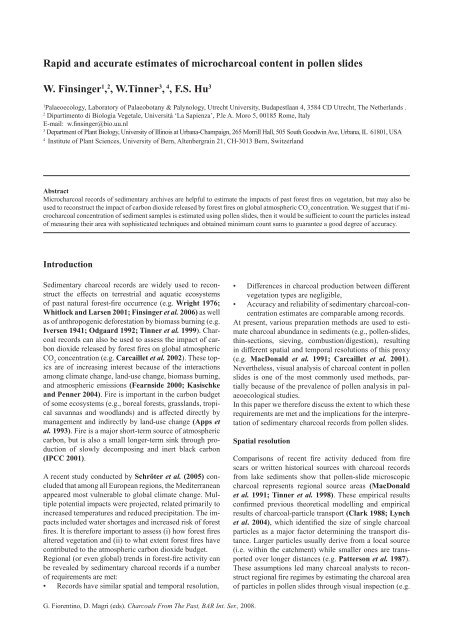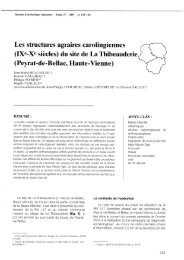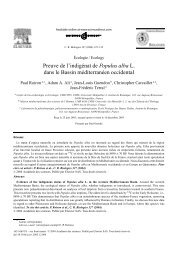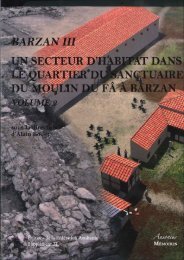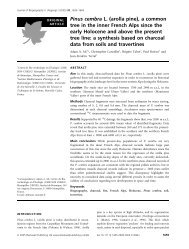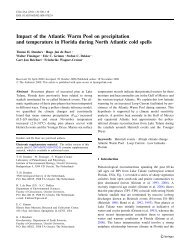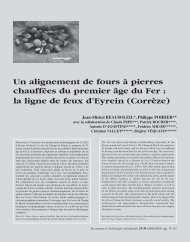Rapid and accurate estimates of microcharcoal content in pollen ...
Rapid and accurate estimates of microcharcoal content in pollen ...
Rapid and accurate estimates of microcharcoal content in pollen ...
Create successful ePaper yourself
Turn your PDF publications into a flip-book with our unique Google optimized e-Paper software.
<strong>Rapid</strong> <strong>and</strong> <strong>accurate</strong> <strong>estimates</strong> <strong>of</strong> <strong>microcharcoal</strong> <strong>content</strong> <strong>in</strong> <strong>pollen</strong> slides<br />
W. F<strong>in</strong>s<strong>in</strong>ger 1 , 2 , W.T<strong>in</strong>ner 3 , 4 , F.S. Hu 3<br />
1<br />
Palaeoecology, Laboratory <strong>of</strong> Palaeobotany & Palynology, Utrecht University, Budapestlaan 4, 3584 CD Utrecht, The Netherl<strong>and</strong>s .<br />
2<br />
Dipartimento di Biologia Vegetale, Università ‘La Sapienza’, P.le A. Moro 5, 00185 Rome, Italy<br />
E-mail: w.f<strong>in</strong>s<strong>in</strong>ger@bio.uu.nl<br />
3<br />
Department <strong>of</strong> Plant Biology, University <strong>of</strong> Ill<strong>in</strong>ois at Urbana-Champaign, 265 Morrill Hall, 505 South Goodw<strong>in</strong> Ave, Urbana, IL 61801, USA<br />
4<br />
Institute <strong>of</strong> Plant Sciences, University <strong>of</strong> Bern, Altenbergra<strong>in</strong> 21, CH-3013 Bern, Switzerl<strong>and</strong><br />
Abstract<br />
Microcharcoal records <strong>of</strong> sedimentary archives are helpful to estimate the impacts <strong>of</strong> past forest fires on vegetation, but may also be<br />
used to reconstruct the impact <strong>of</strong> carbon dioxide released by forest fires on global atmospheric CO 2<br />
concentration. We suggest that if <strong>microcharcoal</strong><br />
concentration <strong>of</strong> sediment samples is estimated us<strong>in</strong>g <strong>pollen</strong> slides, then it would be sufficient to count the particles <strong>in</strong>stead<br />
<strong>of</strong> measur<strong>in</strong>g their area with sophisticated techniques <strong>and</strong> obta<strong>in</strong>ed m<strong>in</strong>imum count sums to guarantee a good degree <strong>of</strong> accuracy.<br />
Introduction<br />
Sedimentary charcoal records are widely used to reconstruct<br />
the effects on terrestrial <strong>and</strong> aquatic ecosystems<br />
<strong>of</strong> past natural forest-fire occurrence (e.g. Wright 1976;<br />
Whitlock <strong>and</strong> Larsen 2001; F<strong>in</strong>s<strong>in</strong>ger et al. 2006) as well<br />
as <strong>of</strong> anthropogenic deforestation by biomass burn<strong>in</strong>g (e.g.<br />
Iversen 1941; Odgaard 1992; T<strong>in</strong>ner et al. 1999). Charcoal<br />
records can also be used to assess the impact <strong>of</strong> carbon<br />
dioxide released by forest fires on global atmospheric<br />
CO 2<br />
concentration (e.g. Carcaillet et al. 2002). These topics<br />
are <strong>of</strong> <strong>in</strong>creas<strong>in</strong>g <strong>in</strong>terest because <strong>of</strong> the <strong>in</strong>teractions<br />
among climate change, l<strong>and</strong>-use change, biomass burn<strong>in</strong>g,<br />
<strong>and</strong> atmospheric emissions (Fearnside 2000; Kasischke<br />
<strong>and</strong> Penner 2004). Fire is important <strong>in</strong> the carbon budget<br />
<strong>of</strong> some ecosystems (e.g., boreal forests, grassl<strong>and</strong>s, tropical<br />
savannas <strong>and</strong> woodl<strong>and</strong>s) <strong>and</strong> is affected directly by<br />
management <strong>and</strong> <strong>in</strong>directly by l<strong>and</strong>-use change (Apps et<br />
al. 1993). Fire is a major short-term source <strong>of</strong> atmospheric<br />
carbon, but is also a small longer-term s<strong>in</strong>k through production<br />
<strong>of</strong> slowly decompos<strong>in</strong>g <strong>and</strong> <strong>in</strong>ert black carbon<br />
(IPCC 2001).<br />
A recent study conducted by Schröter et al. (2005) concluded<br />
that among all European regions, the Mediterranean<br />
appeared most vulnerable to global climate change. Multiple<br />
potential impacts were projected, related primarily to<br />
<strong>in</strong>creased temperatures <strong>and</strong> reduced precipitation. The impacts<br />
<strong>in</strong>cluded water shortages <strong>and</strong> <strong>in</strong>creased risk <strong>of</strong> forest<br />
fires. It is therefore important to assess (i) how forest fires<br />
altered vegetation <strong>and</strong> (ii) to what extent forest fires have<br />
contributed to the atmospheric carbon dioxide budget.<br />
Regional (or even global) trends <strong>in</strong> forest-fire activity can<br />
be revealed by sedimentary charcoal records if a number<br />
<strong>of</strong> requirements are met:<br />
• Records have similar spatial <strong>and</strong> temporal resolution,<br />
• Differences <strong>in</strong> charcoal production between different<br />
vegetation types are negligible,<br />
• Accuracy <strong>and</strong> reliability <strong>of</strong> sedimentary charcoal-concentration<br />
<strong>estimates</strong> are comparable among records.<br />
At present, various preparation methods are used to estimate<br />
charcoal abundance <strong>in</strong> sediments (e.g., <strong>pollen</strong>-slides,<br />
th<strong>in</strong>-sections, siev<strong>in</strong>g, combustion/digestion), result<strong>in</strong>g<br />
<strong>in</strong> different spatial <strong>and</strong> temporal resolutions <strong>of</strong> this proxy<br />
(e.g. MacDonald et al. 1991; Carcaillet et al. 2001).<br />
Nevertheless, visual analysis <strong>of</strong> charcoal <strong>content</strong> <strong>in</strong> <strong>pollen</strong><br />
slides is one <strong>of</strong> the most commonly used methods, partially<br />
because <strong>of</strong> the prevalence <strong>of</strong> <strong>pollen</strong> analysis <strong>in</strong> palaeoecological<br />
studies.<br />
In this paper we therefore discuss the extent to which these<br />
requirements are met <strong>and</strong> the implications for the <strong>in</strong>terpretation<br />
<strong>of</strong> sedimentary charcoal records from <strong>pollen</strong> slides.<br />
Spatial resolution<br />
Comparisons <strong>of</strong> recent fire activity deduced from fire<br />
scars or written historical sources with charcoal records<br />
from lake sediments show that <strong>pollen</strong>-slide microscopic<br />
charcoal represents regional source areas (MacDonald<br />
et al. 1991; T<strong>in</strong>ner et al. 1998). These empirical results<br />
confirmed previous theoretical modell<strong>in</strong>g <strong>and</strong> empirical<br />
results <strong>of</strong> charcoal-particle transport (Clark 1988; Lynch<br />
et al. 2004), which identified the size <strong>of</strong> s<strong>in</strong>gle charcoal<br />
particles as a major factor determ<strong>in</strong><strong>in</strong>g the transport distance.<br />
Larger particles usually derive from a local source<br />
(i.e. with<strong>in</strong> the catchment) while smaller ones are transported<br />
over longer distances (e.g. Patterson et al. 1987).<br />
These assumptions led many charcoal analysts to reconstruct<br />
regional fire regimes by estimat<strong>in</strong>g the charcoal area<br />
<strong>of</strong> particles <strong>in</strong> <strong>pollen</strong> slides through visual <strong>in</strong>spection (e.g.<br />
g. fiorent<strong>in</strong>o, d. magri (eds). Charcoals From The Past, BAR Int. Ser., 2008.
W. F<strong>in</strong>s<strong>in</strong>ger, W.T<strong>in</strong>ner, F.S. Hu<br />
Wadd<strong>in</strong>gton 1969; Swa<strong>in</strong> 1973; Clark 1982) or with<br />
computer-aided techniques (image analysis).<br />
The question whether it is really necessary to measure or<br />
estimate <strong>microcharcoal</strong> areas has been addressed recently<br />
by T<strong>in</strong>ner <strong>and</strong> Hu (2003), who analysed the relationship<br />
between particle-number <strong>and</strong> particle-area concentration<br />
at three different sites <strong>in</strong> different biomes. Their comparison<br />
showed that area concentration (mm 2 cm -3 ) <strong>and</strong><br />
number concentration (number <strong>of</strong> charcoal particles cm -3 )<br />
<strong>of</strong> charcoal particles <strong>in</strong> <strong>pollen</strong> slides are strongly correlated<br />
at all three studied sites (Fig. 1). They further established<br />
regression equations for each <strong>of</strong> the three sites <strong>and</strong><br />
assessed to what degree the area concentration at one site<br />
could be predicted us<strong>in</strong>g either regression (Fig. 1). Results<br />
<strong>in</strong>dicated that as long as the same <strong>pollen</strong>-preparation technique<br />
%):(!$%!%%<br />
is used, the equation from one site can be used to<br />
predict<br />
))2%)%$$<br />
area concentration at other sites even if different<br />
vegetation types occur.<br />
$()*)$)(%;3?3<br />
Hence, it is unnecessary to measure or estimate microscopic<br />
charcoal areas <strong>in</strong> st<strong>and</strong>ard <strong>pollen</strong>-slides (T<strong>in</strong>ner et<br />
( )$) % % 0 */<br />
al.<br />
**$%:(()%:(!0<br />
1998; T<strong>in</strong>ner <strong>and</strong> Hu 2003). The authors, however,<br />
warned<br />
$()*)$$$%<br />
that the high number-area correlation is partially<br />
&!)!!& *$$(3<br />
Difference between vegetation types<br />
If the relationships between charcoal area concentration<br />
<strong>and</strong> number concentration are similar among sites <strong>of</strong> vegetation<br />
types, then tedious calibration analyses would be<br />
not strictly necessary at all sites. T<strong>in</strong>ner <strong>and</strong> Hu (2003)<br />
further suggested that differences <strong>in</strong> charcoal size <strong>and</strong><br />
size-class distribution among sites ma<strong>in</strong>ly reflected different<br />
preparation techniques <strong>of</strong> <strong>pollen</strong> samples. These<br />
authors concluded that differences <strong>in</strong> vegetation type or<br />
other factors (e.g., changes <strong>in</strong> fire regime related to different<br />
climatic conditions) are unimportant <strong>and</strong> attributed<br />
the similarities <strong>in</strong> size <strong>and</strong> size-class distribution to some<br />
(yet unknown) reason related to specific <strong>pollen</strong>-preparation<br />
steps. $0$ They suggested $)? that removal (0* <strong>of</strong> large charcoal )<br />
)!!<br />
() particles through % 0 siev<strong>in</strong>g <strong>and</strong> decant<strong>in</strong>g F is ) almost F/$ certa<strong>in</strong>ly<br />
)( a contribut<strong>in</strong>g factor, 0 though ; (>2? not the only. However, ) if the<br />
*$!$ goal is not */** the reconstruction *3 <strong>of</strong> regional % () fire history % (e.g.<br />
0&!$%$*$%(%&)<br />
by us<strong>in</strong>g the <strong>pollen</strong>-slide technique), differences <strong>of</strong> vegetation<br />
types may be <strong>of</strong> <strong>in</strong>terest.<br />
)$0$ $(!$%(%<br />
For <strong>in</strong>stance, <strong>in</strong>clud<strong>in</strong>g<br />
<br />
all<br />
<br />
charcoal-size<br />
% 3 2&<br />
fractions released<br />
! %<br />
dur<strong>in</strong>g<br />
<br />
fire<br />
<br />
may<br />
<br />
be<br />
%<br />
important<br />
for deriv<strong>in</strong>g global <strong>estimates</strong><br />
$($!!% ;33<br />
<strong>of</strong> biomass<br />
(%<br />
burn<strong>in</strong>g.<br />
*/) $%:(? )!!$! & *<br />
Achiev<strong>in</strong>g this goal is challeng<strong>in</strong>g at present because it is<br />
0 !3$$()$%$/<br />
difficult to (i) estimate the combustion completeness or<br />
F!$))(!0 0*!<br />
fraction <strong>of</strong> biomass consumed dur<strong>in</strong>g fires as a function <strong>of</strong><br />
)&0!0(3$%&<br />
%$%*$()!!$(<br />
fuel type <strong>and</strong> moisture, <strong>and</strong> (ii) measure emission factors<br />
;?0%$0($0*!$!<br />
for various trace gases <strong>and</strong> particulate matter for different<br />
0$(0))(!!($!!( vegetation types <strong>and</strong> fuel moisture <strong>content</strong> (see for example<br />
discussion 0( <strong>in</strong> ) Kasischke, ;? 0( Penner 0 2004). !$ !<br />
*<br />
)<br />
&($)*$(0!)!!<br />
& Accuracy <strong>and</strong> * reliability ) !( 0( <strong>of</strong> sedimentary $ charcoalconcentration<br />
<strong>estimates</strong> between<br />
; !<br />
50*)$(A$%>)"77?3<br />
samples<br />
,#+%(%+'-+ %.<br />
-()-%<br />
Charcoal analysts us<strong>in</strong>g the <strong>pollen</strong>-slide technique have to<br />
-%$ decide about the (%*/)$%:(%&<br />
m<strong>in</strong>imum count<strong>in</strong>g sum needed to produce<br />
<strong>accurate</strong> ( % results 00(0 <strong>in</strong> <strong>pollen</strong>-slides. $( (0 Different )) authors <br />
)$)<br />
*)($ have made $$( different ( choices: for */)3 <strong>in</strong>stance, Carcaillet .!! et al.<br />
(% (2001) as %& well 0) as Carrión )!! et al. $%$1 (2003) scanned ! $ the total<br />
-$ surface <strong>of</strong> - each ;77?2-J <strong>pollen</strong>-slide, while Odgaard - (1992) ;77? analysed<br />
for % each sample (!$ at least ! one $% entire */) slide, or, 2% <strong>in</strong> case<br />
$)<br />
@));88? <strong>of</strong> abundant charcoal-particles, )!$%0*<br />
half a slide. In contrast,<br />
)$!()$%$/*$<br />
T<strong>in</strong>ner, Conedera (1995) chose a m<strong>in</strong>imum count<strong>in</strong>g sum<br />
%! <strong>of</strong> at least )3 200 charcoal-particles $ ) for each -) sample, ;88+? while<br />
$%00(0$((0!77$%$/<br />
others (e.g. MacDonald et al. 1991; Sarmaja-Korjonen<br />
*$!$%0*2%%;33D$.)<br />
1998; T<strong>in</strong>ner et al. 1999; T<strong>in</strong>ner et al. 2000; Darbyshire<br />
388=0B/AB88,=3888=<br />
3 1 -%$ $$ ;0() 0 ? et al. 2003) measured or counted at least 100 <strong>in</strong>dividual<br />
$0*) (0 $$) *)$) $$ 3777=. charcoal fragments. On the %377?0()<br />
other h<strong>and</strong> some authors do not<br />
(%)2)!!;)2!0T<strong>in</strong>ner $()77)&)($%$!03@<br />
reveal the count<strong>in</strong>g sum they used for charcoal analysis.<br />
<strong>and</strong> Hu, 2003?<br />
%%%)0(%)&%$(<br />
This issue has been recently addressed by F<strong>in</strong>s<strong>in</strong>ger<br />
(0% <strong>and</strong> T<strong>in</strong>ner ()!$%$ (2005). Given the 3 assumption <strong>of</strong> homogeneous<br />
distribution <strong>of</strong> particles ))) on <strong>pollen</strong> slides, ) the <strong>in</strong>ferred<br />
$ ($ 0( 0 %(%$<br />
because 0$$*$ large $%$ particles (which tend )) to dom<strong>in</strong>ate */) the total <br />
area ;388,=)(77?3%(%<br />
concentration) were elim<strong>in</strong>ated dur<strong>in</strong>g <strong>pollen</strong> process<strong>in</strong>g<br />
%2&2)%%%%(0/$<br />
<strong>and</strong> because small particles (
<strong>Rapid</strong> <strong>and</strong> <strong>accurate</strong> <strong>estimates</strong> <strong>of</strong> <strong>microcharcoal</strong> <strong>content</strong> <strong>in</strong> <strong>pollen</strong> slides<br />
Excel (© Micros<strong>of</strong>t Corporation; Fig. 2).<br />
Below 200 items (i.e., the sum <strong>of</strong> charcoal particles <strong>and</strong><br />
exotic marker gra<strong>in</strong>s), reconstructed number concentration<br />
is either too high or too low. Statistical comparisons show<br />
that the means <strong>of</strong> bootstrap simulations stabilize after 200<br />
counts. A count <strong>of</strong> 200-300 items is sufficient to produce a<br />
charcoal-concentration estimate with less than ±5% error<br />
if compared with high-count samples <strong>of</strong> 1000 items for<br />
charcoal/marker gra<strong>in</strong> ratios p>0.1, p P33 The 8,,3 Holocene, "$13, 0 537-546. ) % ! $%$ 1<br />
77 **)%$!)03"*+/<br />
regrowth <strong>in</strong> northern Ethiopia dur<strong>in</strong>g the last 3000 years.<br />
0>))32&%$((0!77 ++3<br />
$%$!00 %%0$3<br />
techniques may be more promis<strong>in</strong>g (e.g. Thevenon et al., ($*)*)0*3R( Ef r o n, B., Ti b s h i r a n i, R.J., 1991. Statistical data analysis $% <strong>in</strong> the<br />
50*2% N73
W. F<strong>in</strong>s<strong>in</strong>ger, W.T<strong>in</strong>ner, F.S. Hu<br />
<strong>of</strong> atmospheric emissions from biomass burn<strong>in</strong>g. Journal<br />
<strong>of</strong> Geophysical Research-Atmospheres, 109, D14.<br />
Ly n c h, J.A., Cl a r k, J.S., St o c k s, B.J., 2004. Charcoal productions,<br />
dispersal, <strong>and</strong> deposition from the Fort Providence<br />
experimental fire: <strong>in</strong>terpret<strong>in</strong>g fire regimes from charcoal<br />
records <strong>in</strong> boreal forests. Canadian Journal <strong>of</strong> Forest<br />
Research, 34, 1642-1656.<br />
Ma cDo n a l d, G.M., La r s e n, C.P.S., Sz e i c z, J.M., Mo s e r, K.A.,<br />
1991. The Reconstruction <strong>of</strong> Boreal Forest Fire History<br />
from Lake Sediments - a Comparison <strong>of</strong> Charcoal,<br />
Pollen, Sedimentological, <strong>and</strong> Geochemical Indexes.<br />
Quaternary Science Reviews, 10, 53-71.<br />
Od g a a r d, B.V., 1992. The fire history <strong>of</strong> Danish heathl<strong>and</strong><br />
areas as reflected by <strong>pollen</strong> <strong>and</strong> charred particles <strong>in</strong> lake<br />
sediments. The Holocene, 2, 218-226.<br />
Pat t e r s o n, W.A., Ed wa r d s, K.J., Ma g u i r e, D.J., 1987.<br />
Microscopic charcoal as a fossil <strong>in</strong>dicator <strong>of</strong> fire.<br />
Quaternary Science Reviews, 6, 3-23.<br />
Sa r m a j a-Ko r j o n e n, K., 1998. Latitud<strong>in</strong>al differences <strong>in</strong> the<br />
<strong>in</strong>flux <strong>of</strong> microscopic charred particles to lake sediments<br />
<strong>in</strong> F<strong>in</strong>l<strong>and</strong>. The Holocene, 8, 589-597.<br />
Sc h r ö t e r, D., Cr a m e r , W., Le e m a n s, R., Pr e n t i c e, I.C., Ar a u j o,<br />
M.B., Ar n e l l, N.W., Bo n d e a u, A., Bu g m a n n, H.,<br />
Ca rt e r, T.R., Gr a c i a, C.A., d e l a Ve g a-Le i n e rt, A.C.,<br />
Er h a r d, M., Ew e r t , F., Gl e n d i n i n g, M., Ho u s e, J.I.,<br />
Ka n k a a n pa a, S., Kl e i n, R.J.T., Lav o r e l, S., Li n d n e r, M.,<br />
Me t z g e r, M.J., Me y e r, J., Mi t c h e l l, T.D., Re g i n s t e r, I.,<br />
Ro u n s e v e l l, M., Sa b at e , S., Si t c h, S., Sm i t h, B., Sm i t h,<br />
J., Sm i t h, P., Sy k e s, M.T., Th o n i c k e, K., Th u i l l e r, W.,<br />
Tu c k, G., Za e h l e, S., Zi e r l, B., 2005. Ecosystem Service<br />
Supply <strong>and</strong> Vulnerability to Global Change <strong>in</strong> Europe.<br />
Science, 310, 1333-1337.<br />
Sw a i n, A.M., 1973. A history <strong>of</strong> fire <strong>and</strong> vegetation <strong>in</strong> northeastern<br />
M<strong>in</strong>nesota as recorded <strong>in</strong> lake sediment. Quaternary<br />
Research, 3, 383-396.<br />
Th e v e n o n, F., Wi l l i a m s o n, D., Vi n c e n s, A., Ta i e b, M., Me r d a c i,<br />
O., De c o b e rt, M., Bu c h e t, G., 2003. A late-Holocene<br />
charcoal record from Lake Masoko, SW Tanzania:<br />
climatic <strong>and</strong> anthropologic implications. The Holocene,<br />
13, 785-792.<br />
Ti n n e r, W., Co n e d e r a, M., 1995. Indag<strong>in</strong>i paleobotaniche sulla<br />
storia della vegetazione e degli <strong>in</strong>cendi forestali durante<br />
l’Olocene al Lago di Origlio (Tic<strong>in</strong>o meridionale).<br />
Bollett<strong>in</strong>o della Società Tic<strong>in</strong>ese di Scienze Naturali, 83,<br />
91-106.<br />
Ti n n e r, W., Co n e d e r a, M., Am m a n n , B., Gä g g e l e r, H.W., Ge d y e,<br />
S., Jo n e s, R., Sä g e s s e r, B., 1998. Pollen <strong>and</strong> charcoal <strong>in</strong><br />
lake sediments compared with historically documented<br />
forest fires <strong>in</strong> southern Switzerl<strong>and</strong> s<strong>in</strong>ce AD 1920. The<br />
Holocene, 8, 31-42.<br />
Ti n n e r, W., Co n e d e r a, M., Go b e t, E., Hu b s c h m i d, P., We h r l i,<br />
M., Am m a n n , B., 2000. A palaeoecological attempt to<br />
classify fire sensitivity <strong>of</strong> trees <strong>in</strong> the southern Alps. The<br />
Holocene, 10, 565-574.<br />
Ti n n e r, W., Hu, F.S., 2003. Size parameters, size-class distribution<br />
<strong>and</strong> area-number relationship <strong>of</strong> microscopic charcoal:<br />
relevance for fire reconstruction. The Holocene, 13, 499-<br />
505.<br />
Ti n n e r, W., Hu b s c h m i d, P., We h r l i, M., Am m a n n , B., Co n e d e r a,<br />
M., 1999. Long-term forest fire ecology <strong>and</strong> dynamics <strong>in</strong><br />
southern Switzerl<strong>and</strong>. Journal <strong>of</strong> Ecology, 87, 273-289.<br />
Wa d d i n g t o n, J.C.B., 1969. A stratigraphic record <strong>of</strong> the <strong>pollen</strong><br />
<strong>in</strong>flux to a lake <strong>in</strong> the Big Woods <strong>of</strong> M<strong>in</strong>nesota. Geological<br />
Society <strong>of</strong> America, Special Paper, 123, 263-283.<br />
Wh i t l o c k, C., La r s e n, C., 2001. Charcoal as a fire proxy. In: J.P.<br />
Smol, H.J.B. Birks, W.M. Last, eds. Terrestrial, Algal, <strong>and</strong><br />
Siliceous Indicators. Track<strong>in</strong>g Environmental Change<br />
Us<strong>in</strong>g Lake Sediments. Dordrecht, The Netherl<strong>and</strong>s:<br />
Kluwer Academic Publishers, 75-97.<br />
Wr i g h t, R.F., 1976. The impact <strong>of</strong> forest fire on the nutrient<br />
<strong>in</strong>fluxes to small lakes <strong>in</strong> northeastern M<strong>in</strong>nesota.<br />
Ecology, 57, 649-663.<br />
124


